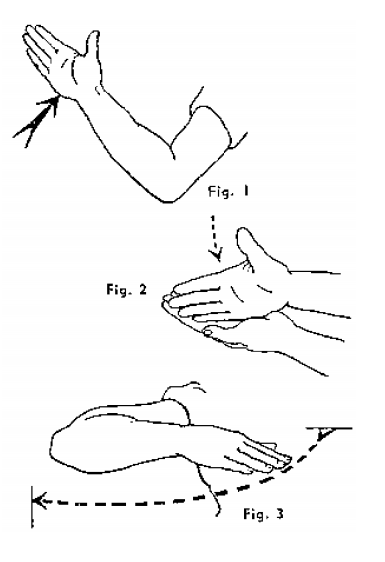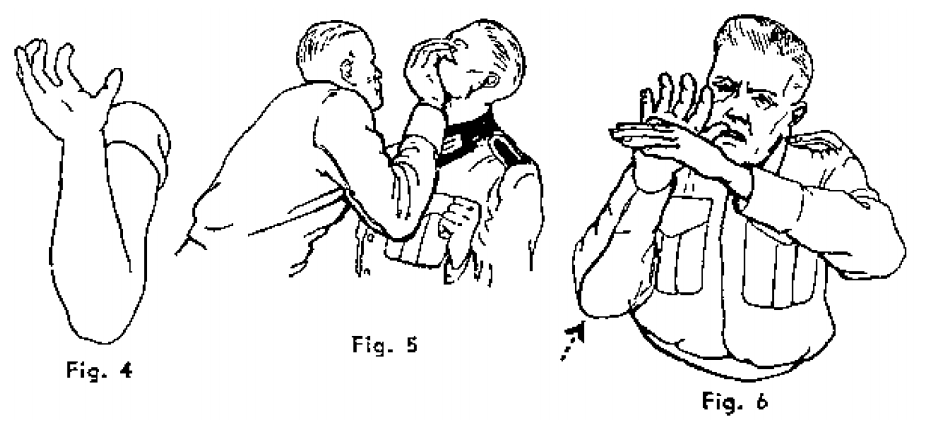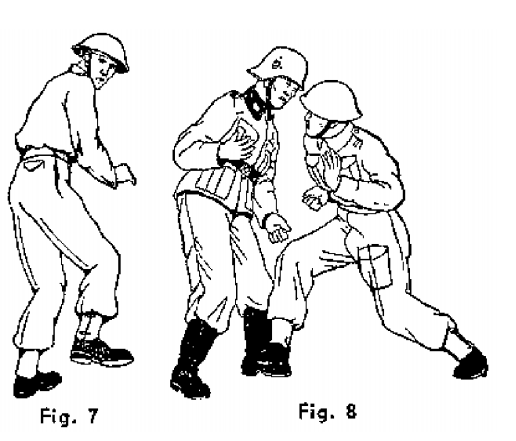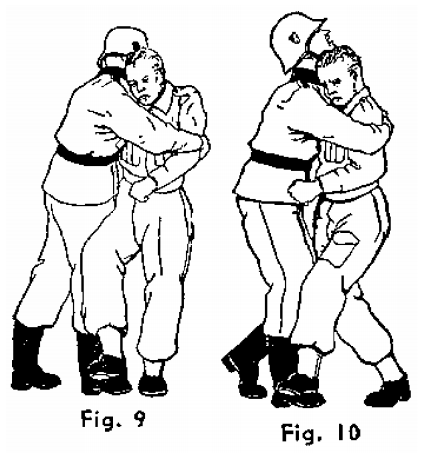GET TOUGH !
MAJOR W.E. Fairbairn 1943
BLOWS
|
NO. 1 - EDGE-OF-THE-HAND
Deliver edge-the-hand blows with the inner (i.e., little-finger) edge e hand, fingers straight and close together, thumb extended. Contact is made with the edge only, about half-way between the knuckle of the little finger and the wrist, as shown in Fig. 1. 1. Deliver the blow with a bent arm (never with a straight arm), using a chopping action from the elbow, with the weight of the body behind it. Practice by striking the open palm of your left hand, as in Fig. 2. 2. There are two ways in which this blow can be delivered: (a) Downwards, with either hand; (b) Across, with cither hand; the blow always being delivered outwards, with the palm of the hand downwards, never on top (Fig. 3). |
|
3. Attack the following points on your opponent's body, delivering every blow as quickly as possible:
(a) The sides or back of the wrist; (b) The forearm, half-way between the wrist and elbow; (c) The biceps; (d) The sides or back of the neck; (e) Just below the "Adam's apple"; (f) The kidneys or base of the spine. |
Note. - If your opponent catches hold of you, strike his wrist or forearm; a fracture will most likely result. This would be almost impossible with a blow from a clenched fist.
|
NO. 2 - CHIN JAB
Deliver this blow with the heel of your hand, full force, with the weight of your body behind it, and fingers spread so as to reach your opponent's eyes, as in Fig. 4. Always aim at the point of your opponent's chin (Fig. 5)
Deliver the blow upwards from a bent arm and only when close to your opponent. The distance the blow will have to travel will depend on the height of your opponent, but will seldom exceed six inches.
Deliver this blow with the heel of your hand, full force, with the weight of your body behind it, and fingers spread so as to reach your opponent's eyes, as in Fig. 4. Always aim at the point of your opponent's chin (Fig. 5)
Deliver the blow upwards from a bent arm and only when close to your opponent. The distance the blow will have to travel will depend on the height of your opponent, but will seldom exceed six inches.
Note.- Practice this blow as follows: Hold your left hand at the height of your own chin, palm downwards; jab up quickly with your right, striking your left hand, as in Fig. 6.
|
NO. 3 - BOOT (SIDE KICK)
With a few exceptions, you should always kick sideways, for you are thus able to put more force behind your blow and can, if necessary, reach farther. 1. Turn your right side to your opponent, putting the weight of your body on your left foot. Bending your left leg slightly from your knee, raise your right foot two to four inches off the ground, as in Fig. 7. Shoot your right foot outwards and upwards to your right, aiming to strike your opponent's leg just below the knee-cap. |
2. Follow the blow through, scraping down your opponent's shin with the edge of your boot from the knee to the instep, finishing up with all your weight on your right foot, smashing the small bones of his foot. If necessary, follow up with a chin jab with your left hand (Fig. 8).
Note. - Where the kick is to be made with the left foot, reverse the above.
Note. - Where the kick is to be made with the left foot, reverse the above.
|
NO. 3A - BOOT DEFENSE
Your opponent has seized you around the body from in front, pinning your arms to your sides. 1. Having put your weight on one foot, raise the other and scrape your opponent's shinbone downwards from about half way from the knee, finishing up with a smashing blow on his foot (Fig. 9). 2. An alternative method to Fig. 9, permitting you to use the inner edge of the boot, is shown in Fig. 10). |
|
Note A. - Whether you should use the outside or inside of your boot will depend upon how the weight of your body is distributed at the time. Provided that you are equally balanced on both feet, you can use either; otherwise, use the one opposite to that on which you have your weight.
|
Note B. - lf seized from behind, stamp on your opponent's foot with the heel of either boot, turning quickly and following up with a chin jab with either hand.
|
|
NO. 3B - BOOT ("BRONCO KICK")
Your opponent is lying on the ground. 1. Take a flying jump at your opponent, drawing your feet up by bending your knees, at the same time keeping your feet close together (Fig. 11) 2. When your feet are approximately eight inches above your opponent's body, shoot your legs out straight, driving both of your boots into his body, and smash him. |
Note. - It is almost impossible for your opponent to parry a kick made in this manner, and, in addition, it immediately puts him on the defensive, leaving him only the alternative of rolling away from you in an attempt to escape. Further, although he may attempt to protect his body with his arms, the weight of your body (say 150 pounds), plus the impetus of your flying jump (say another 150 pounds), will drive your heels into your opponent's body with such terrific force that you will almost certainly kill him. Steel heel-plates on your boots will make his attack even more effective.
Practice this kick on a dummy figure or on the grass as in Fig. 12.
Practice this kick on a dummy figure or on the grass as in Fig. 12.
|
NO. 4 - KNEE
This blow can be delivered only when you are very close to your opponent. 1. Putting the weight of your body on one leg, bend the knee of the other by drawing your heel slightly backwards, and drive your knee quickly upwards into your opponent's testicles (Fig. 13). Note. - This blow is frequently used to bring your opponent into a more favorable position for applying the chin jab (Fig. 14). |






